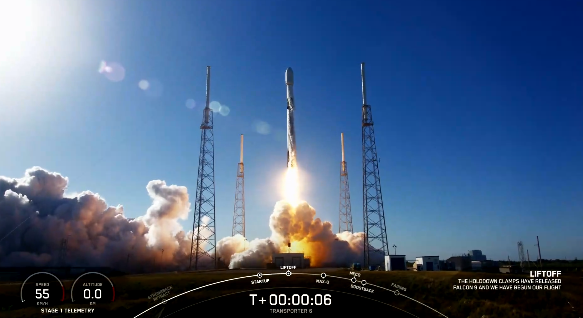Latest News

SpaceX launches its Transporter 6 rideshare mission on Jan. 3, 2023, from Cape Canaveral. Photo: Screenshot via SpaceX.
SpaceX kicked off 2023 with a rideshare mission on Tuesday morning, launching 114 spacecraft to orbit. The mission — Transporter 6 — was the sixth in SpaceX’s series of dedicated rideshare missions for smallsat customers.
A Falcon 9 rocket took off from Cape Canaveral Space Force Station in Florida at 9:56 a.m. ET. The mission lasted about 1 hour and 31 minutes, releasing the spacecraft in a series of 82 deployments.
SpaceX started off its year of launches as CNBC reports that the company is raising $750 million in a new round of funding that values the company at $137 billion, led by Andreessen Horowitz, or a16z.
The Transporter 6 manifest reads like a who’s who of smallsat customers. The 114 spacecraft on the mission included cubesats, microsats, picosats, and orbital transfer vehicles carrying spacecraft to be deployed at a later time
Planet was the largest customer on the mission, with 36 SuperDove satellites on board. These SuperDoves, Flock 4y, will replenish Planet’s current fleet of approximately 200 satellites in orbit.
Swarm Technologies, a satellite IoT company now owned by SpaceX, flew 12 very high frequency (VHF) satellites on the mission, Swarm confirmed on Jan. 4.
Spire Global had six satellites on the mission including two demonstration satellites with Automatic Dependent Surveillance-Broadcast (ADS-B) payload to collect aircraft position data. These satellites are Spire’s first satellites to have propulsion systems onboard and also will support IoT provider Myriota, a space services customer. Another Spire satellite has a polarimetric radio occultation (PRO) payload that collects data on precipitation profiles and patterns, as part of the European Space Agency (ESA) InCubed Programme.
A number of space tugs and orbital transfer vehicles flew on the mission. Momentus launched its second orbital transfer vehicle, Vigoride 5, with payloads for the California Institute of Technology and Qosmosys. Epic Aerospace had its Chimera chemical space tug on the mission.
Rideshare company Launcher had its first space tug and hosted payload platform, Orbiter SN1, on the mission with eight customers: Stanford Space Initiative, Cal Poly Pomona, Innova Space, NPC Spacemind, Logitech, Alba Orbital, and Beyond Burial.
Italian space logistics company D-Orbit had its seventh commercial mission, with two ION satellite carriers. D-Orbit supported customers NPC Spacemind with two satellites FUTURA-1 and FUTURA-3, five satellites for IoT company Astrocast, and satellites from the Sharjah Academy for Astronomy, Space Sciences in the UAE and and Tel Aviv University in Israel,onboard through a contract with ISIS Space. It also launched a Kelpie 1, a cubesat to collect Automatic Identification System (AIS) data for Orbcomm.
Smallsat manufacturer NanoAvionics had a number of satellites on the mission: Gama’s Alpha satellite, a European solar sail mission, and the joint Norwegian and Dutch mission MilSpace2, comprised of the Huygens and Birkeland satellite duo, which will geolocate radio frequency signals.
German rideshare provider Exolaunch supported customer Unseenlabs with its BRO-8 nanosatellite for RF monitoring and Open Cosmos with the MENUT Earth observation nanosatellite which will form part of the OpenConstellation.
Earth observation company Satellogic had four satellites on the mission.
RF monitoring company Kleos Space had four satellites on the mission by working with Spaceflight and ISISpace Group.
Synthetic Aperture radar (SAR) company Umbra had two satellites on the mission, and Finnish SAR company Iceye had three satellites on the mission.
Polish space company Scanway launched its demonstration mission Star Vibe, a cubesat with two optical payloads, one for EO and another to self-diagnose satellites on orbit.
Lynk had two satellites, which it calls cell towers in space, for satellite direct-to-cell service.
BeetleSat, formerly known as NSLComm, launched its second nanosatellite, which will provide high throughput, store and forward communications for public sector customers.
Space as a service company Loft Orbital had its YAM-5 spacecraft on the mission, supporting a full manifest of customers.
Australian company Skykraft sent the largest Australian-made payload into space at 300 kg. The stack of five satellites are the first of more than 200 satellites to form a constellation for a global air traffic management service.
U.S. Space Force Space Systems Command launched its electro-optical/infrared (EO/IR) weather systems cubesat technical demonstration, which will prove out emerging space-based EO/IR radiometric imaging technology, using a smaller sensor to provide timely weather imagery data.
South African company Dragonfly Aerospace saw the launch of its first imaging satellite, EOS SAT-1 for customer EOS Data Analytics. Dragonfly Aerospace is building seven satellites for EOS Data Analytics, which will use the data to support sustainable agriculture methods.
Bulgarian manufacturer EnduroSat launched its first shared mission, Platform-2. It included Magdrive’s first space flight, an in-orbit demonstration of a high-power electric plasma thruster and Hypernova, which will validate its proprietary plasma electric propulsion system in orbit.
It was also a key mission for a number of countries and regions — Albania, Kuwait, and the Catalonia region of Spain had satellites on the launch.
SpaceX started the 2023 launch tally early in the year, after closing out a company record in 2022 with 61 launches — nearly doubling from 31 launches in 2021. The launcher closed out 2022 lofting Earth observation satellite EROS C-3 to orbit for Israeli EO company ImageSat International on Dec. 29 from Vandenberg Space Force Base in California, and a Dec. 28 mission from Cape Canaveral with 54 Starlink satellites.
Get the latest Via Satellite news!
Subscribe Now